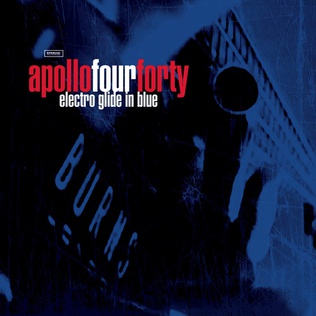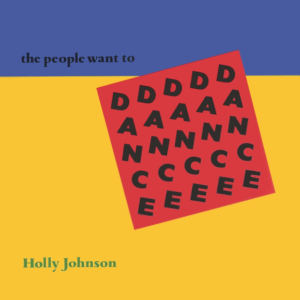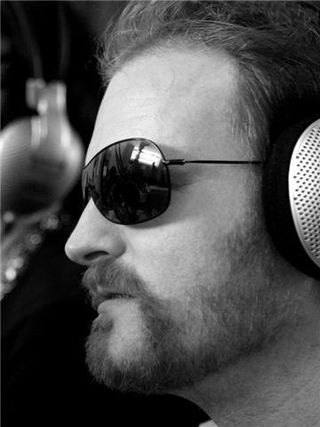
The Apollo command and service module (CSM) was one of two principal components of the United States Apollo spacecraft, used for the Apollo program, which landed astronauts on the Moon between 1969 and 1972. The CSM functioned as a mother ship, which carried a crew of three astronauts and the second Apollo spacecraft, the Apollo Lunar Module, to lunar orbit, and brought the astronauts back to Earth. It consisted of two parts: the conical command module, a cabin that housed the crew and carried equipment needed for atmospheric reentry and splashdown; and the cylindrical service module which provided propulsion, electrical power and storage for various consumables required during a mission. An umbilical connection transferred power and consumables between the two modules. Just before reentry of the command module on the return home, the umbilical connection was severed and the service module was cast off and allowed to burn up in the atmosphere.

Apollo 440 are a British electronic music group formed in Liverpool in 1990. The group has written, recorded, and produced five studio albums, collaborated with and produced other artists, remixed as Apollo 440 and as ambient cinematic alter-ego Stealth Sonic Orchestra, and created music for film, television, advertisements and multimedia. They notched up ten UK top 40 singles with three top-tens, and had a chart presence worldwide.

INXS²: The Remixes or INXS Squared: The Remixes is a collection of remixes of tracks originally by Australian rock group INXS, which was released in April 2004 by Mercury Records/Universal Music Australia. It peaked in the ARIA Albums Chart top 100 and also reached No. 5 on the ARIA Dance Albums Chart. "Suicide Blonde" was remixed by Paul Oakenfold, "New Sensation" by The Beginnerz, and "The Strangest Party" by Apollo 440.

Noko is an English musician, multi-instrumentalist, composer and producer, has formed and/or played with a number of bands primarily as a guitarist or bassist. In chronological order they were: Alvin the Aardvark and the Fuzzy Ants, the Umbrella, the Pete Shelley Group, the Cure, Luxuria, Apollo 440, Stealth Sonic Soul, Fast, Maximum Roach, James Maker and Noko 440, Magazine, Raw Chimp, Levyathan, SCISM, Am I Dead Yet? and Buzzcocks.

Electro Glide in Blue is the second studio album by English electronic music group Apollo 440. It was first released on 3 March 1997 in the United Kingdom by Stealth Sonic Recordings and Epic Records and on 9 September 1997 in the United States by 550 Music. The album features Charles Bukowski, Billy Mackenzie, and a tribute to Gene Krupa; all three of whom had died by the time of the album's release. Its title is a reference to the 1973 film Electra Glide in Blue.

Dude Descending a Staircase is the fourth studio album by English electronic music group Apollo 440. It was released as a double album on 22 July 2003 via Stealth Sonic Recordings and Sony Music UK. Recording sessions took place at Apollo Control in Camden, London. Production was handled by Apollo 440 and Stuart Crichton. It features guest appearances from Jay Dunne, Pete Wylie, Spoonface, The Beatnuts and Tommy Blaize among others. Its title and cover art reference the painting Nude Descending a Staircase by Marcel Duchamp.

"Krupa" is a 1996 song by British big beat/electronic rock band Apollo 440. The cover credits it as appearing in an advert for Sunkist.

Millennium Fever is the debut studio album by English electronic music group Apollo 440, released on 30 January 1995 by Stealth Sonic Recordings and Epic Records.

James Gardner is an English born New Zealand musician and composer. Gardner was born in Liverpool, England. He was a school friend of Noko and Howard Gray, with whom he later formed the band Apollo 440, Gardner spent much of the 1980s in London playing and programming keyboards and synthesizers for a variety of artists. During this time he also formed the short-lived band The Umbrella, where the influence of John Barry can be seen. Later, Gardner was involved with Luxuria, the band formed by Noko and Howard Devoto. In 1990, Gardner along with Noko, Howard Gray, and Trevor Gray, co-founded Apollo 440, an electronic music group.
The Roland JD-990 Super JD is a module version of Roland JD-800 synthesizer with expanded capabilities, which was released in 1993. JD-990 is a multitimbral synthesizer utilizing 'wave-table' sample-based synthesis technology. It is equipped with 6 MB of ROM containing sampled PCM waveforms, four sets of stereo outputs that are assignable to individual, internal, instruments, and standard MIDI in/out/through ports. JD-990 has a large LCD display and programming takes place through a keypad on the front panel of the unit. The unit can generate multi-timbral sounds reminiscent of the vintage analogue synthesizers but is also capable of generation of modern digital textures. There are several expansion boards available for JD-990 that can be installed in the provided expansion slot in the chassis of the unit.
Paul Kodish is an English musician and professional drummer, raised in Willesden, London. Kodish has performed with a variety of different artists, including the hip hop act Whodini in 1986, and the drum and bass group Bad Company. He was also one of two drummers for the electronica band Apollo 440 between 1997 and 2005 and the drummer in the Australian-British drum and bass band Pendulum between 2006 and 2009. Kodish spent a short time in 2010 drumming with the Liverpool band Killaflaw, performing at several concerts and drumming for their debut album Sleaze and Grit. He currently supports DJ Fresh's crew on their FRESH/Live tour.
Krimisa, Crimisa or Crimissa was an ancient town, probably originating in the 7th century BC, situated in modern Calabria in the region of Punta Alice. It was inhabited by an indigenous people assimilated by the Greeks.

"The People Want to Dance" is a single from former Frankie Goes to Hollywood singer Holly Johnson, taken as the third and final single from his 1991 album Dreams That Money Can't Buy. The track would be Johnson's last release until 1994.
A440 or A-440 may refer to:

Howard Gray is an English musician, sound engineer, programmer, composer, re-mixer and producer who has worked with Public Image Ltd, Orchestral Manoeuvres in the Dark, Kirsty MacColl, the Armoury Show, the Pale Fountains, Japan, the Stranglers, Simple Minds, the Pretenders, XTC, UB40, Scritti Politti, Cherubs, Terence Trent D'Arby, Jean Michel Jarre, the Cure, Manic Street Preachers, U2, Puff Daddy & Jimmy Page, Tom Jones and Van Morrison.

"Stop the Rock" is a song by British electronic music group Apollo 440 from their third studio album, Gettin' High on Your Own Supply (1999). Released on 16 August 1999, it was the group's breakout single.

"United" is a song by English popstar Robbie Williams released as a single in 2000 as part of Pepsi's "Ask for More" advertising campaign.
Ian Garfield Hoxley, known by his stage name Mary Byker is an English singer, record producer and DJ known for his work as the lead singer of Gaye Bykers on Acid, Pop Will Eat Itself, Pigface and Apollo 440.
Larisa or Larissa (Λάρισσα) was a town of ancient Lydia. It was in the territory of Ephesus, on the north bank of the Caystrus, which there flowed through a most fertile district, producing an excellent kind of wine. It was situated at a distance of 180 stadia from Ephesus, and 30 from Tralles. In Strabo's time it had sunk to the rank of a village, but it was said once to have been a polis (Πόλις), with a temple of Apollo.

Here is a 2013 artwork created by artist duo Thomson & Craighead. The work, a standard UK road sign pointing northwards, is situated on a riverside path on the west side of the Greenwich Peninsula in south-east London, where it forms part of The Line, a public sculpture trail that very roughly follows the path of the Prime Meridian as it crosses the River Thames.














